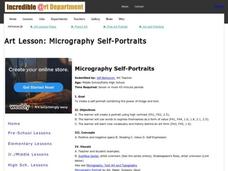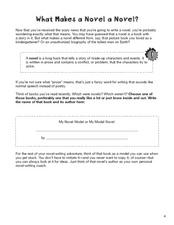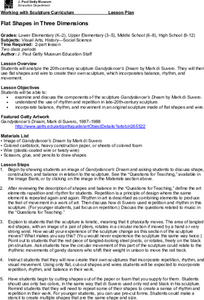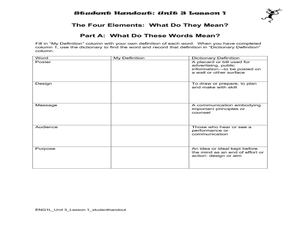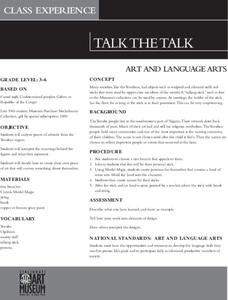Curated OER
Lesson Plan 17: Novel, Take 2
It's all about using peer resources in this writing process lesson, which includes a fantastic novel revision worksheet packet. Learners have read a partner's story draft the night before, and groups have a "lightning round of praise"...
Incredible Art
Micrography Self-Portraits
Words. Words. Words. Class members create micrography self-portraits combining a high contrast portrait photo with words that express themselves. Complete directions for the project, student samples, along with links to professional...
Curated OER
Expository Journal Prompts
Stuck for a journal topic? Download CAHSEE’s 21 “Expository Journal Prompts” as a pdf handout for yourself or class. A great resource for your writing program, print it up and add it your curriculum library.
Curated OER
What Makes a Novel a Novel?
As your authors prepare to write a hypothetical novel, they need all the inspiration they can find! Using a book they have already read (and enjoyed), learners complete a literary analysis by filling in eight short-answer questions....
Curated OER
Modern and Classical Poetry
A fabulous presentation of poetry awaits your students. This rich, 14-slide PowerPoint presents many excellent ways for your pupils to compose poems. The presentation encourages them to play with words when composing poems, to analyze...
Curated OER
The Imagine Poetry & Mural Lesson
Readers of all ages can work together in groups to create original poetry on the theme of "Imagine," inspired by John Lennon's classic song. They also create a mural to illustrate their poetry. A beautiful activity, inspired by a...
Discovery Education
Mood Music!
Grouchy? Sad? Here's a great resource that shows kids how music can be used to lift their spirits. Kids collect and chart data on the effects of music on emotions. After analyzing the results of their experiment, they develop their own...
Pennsylvania Department of Education
Using Literary Elements to Compare Fiction Texts
Students explore language arts by reading and reflecting on literary examples. In this fiction writing instructional activity, students read several different cultural versions of the story "Cinderella" and discuss their interaction with...
Curated OER
Flat Shapes in Three Dimension
Students explore sculpture. In this lesson plan about finding sculpture ideas in movement and rhythm, students make 3-dimensional shapes. Students create a sculpture paying attention to balance, rhythm and repetition. Students will...
Curated OER
LETTER FROM ONE CHARACTER TO ANOTHER
Fourth graders read stories and pick one with characters they find interesting. Then students create a dialogue of writing a letter from one character to another. The letter must relate to the original story in some way that can easily...
Curated OER
The Four Elements of a Good Poster
In this poster worksheet, students fill out a brainstorming chart, advertising elements, and more, to incorporate into their poster. Students complete 4 activities.
Curated OER
Music Elements For Second Grade
Second graders are exposed to a variety of attributes of melody in seven lessons of this unit. the notation in treble clef, pitch, and the movements of the melody are presented in these lessons.
Curated OER
Seeing through Touch
Students explore solid objects using touch. In this art lesson, students are blindfolded and given a 3 dimensional object to explore with their hands. After the object is removed, students draw what they think the object looked like....
Curated OER
Urban Ecosystems 2: Why are There Cities? A Historical Perspective
Second in a series of five lessons, this lesson encourages preteens to consider cities as urban ecosystems. First, they keep a food diary for a few days. They visit the Natrional Agricultural Statistics Service website for current data...
Curated OER
Urban Ecosystems 4: Metabolism of Urban Ecosystems
Cities are compared to living, breathing, metabolizing organisms. Fourth in a five-part series of lessons, this one focuses on the flow of materials through a city. Links to interesting websites and images make your delivery of...
Curated OER
Secret Stories: Exploring the Elements of Folktales and Fables
Students are introduced to the characteristics of fables and folktales. In groups, they read and identify the various elements in the stories they read from around the world. For each story, they analyze the setting and the various...
Curated OER
Talk The Talk
Students create their own "talking sticks" that reflect personas they have invented in this Art lesson designed to introduce the Yoruba peoples from Nigeria. Emphasis is placed on personal reflection after completing the "sticks".
Curated OER
Integrating Anime and Manga into an Art of Motion Picture Course
Students examine the art of Anime and note its characteristics. Using scenes, they identify the plots, characters and themes trying to be portrayed. In groups, they compare and contrast the animation in America to that of Anime and...
Curated OER
Metaphors in Context
Do your class members know where the phrase "raining cats and dogs" come from? They will after viewing a presentation about metaphors. The concise definitions and clear examples make for a strong introduction to this element of...
Curated OER
Language Arts: Character Comparison
Fourth graders, using Kidspiration, compare and contrast the two main characters from Tales of a Fourth Grade Nothing. They use a teacher-created template to describe their characters. Students then create their own character analysis.
Curated OER
Art Attraction: Researching the Great Masters and their Works
Students fill out worksheets where they analyze and provide information about different artists, visual art, art techniques, design, and more. For this art lesson plan, students complete 8 worksheets.
Curated OER
Andy Warhol and Silkscreen Pop Art
Students explore art history by researching famous paintings on-line. In this Andy Warhol lesson, students discuss who Warhol was, his impact on popular art and methods of painting. Students examine his use of silk screen printing and...
Curated OER
Language Arts: Sentence Variety and Fluency
Young scholars are able to identify, create, and evaluate three kinds of sentences: simple, compound, and complex. They are able identify the purpose of various sentence types: declarative, interrogative, imperative, exclamatory, and...



